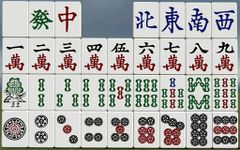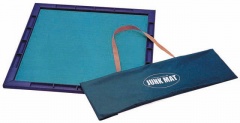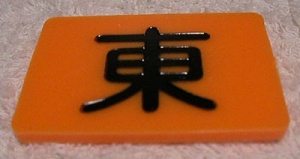Matériel du mahjong
Un matériel adapté est requis pour jouer au mahjong japonais. Cela comprend bien sûr les tuiles de mahjong. Il est possible de jouer au jeu en utilisant des cartes à jouer imprimées, mais ce n'est pas idéal. En pratique les tuiles constituent la meilleure solution pour les parties réelles.
Le jeu existe aussi en ligne, et via des logiciels.
Sommaire
Tuiles japonaises
Les jeux de mahjong comprennent en général 144 tuiles dans une malette. Il y a quatre tuiles de chaque type. Elles ont habituellement deux couleurs, et toutes les tuiles ont la même couleur au dos. Ces couleurs peuvent varier d'un jeu à l'autre. Certains jeux ont des tuiles dont le recto et le verso sont de la même couleur. Dans certains jeux spéciaux, les « Washizu », trois
Au mahjong japonais, on utilise 136 tuiles sur les 144. Celles qui restent sont les quatre 5 rouges de dora : une pour manzu et souzu, et deux pour pinzu. Pour les utiliser, on échange les cinqs ordinaires contre la dora rouge. Les quatre tuiles restantes sont des fleurs, qui ne sont pas utilisées. Typiquement, les tuiles japonaises ont des dimensions de 16 × 19 × 26 mm (largeur, longueur, hauteur). Comme dans la plupart des jeux de mahjong, ces tuiles peuvent tenir sur la tranche.
Les tuiles peuvent être catégorisées de différentes façons. La première sépare les tuiles en suites et en types. Trois groupes de tuiles constituent les suites numérotées, et un autre les honneurs, qui sont à leur tour séparés en dragons et vents. Dans les suites numérotées, les tuiles de 2 à 8 sont les tuiles simples, et les tuiles 1 et 9 sont les terminales.
Les tuiles sont listées dans cet article dans l'ordre utilisé pour la dora.
Man
| |
|
|
|
|
|
|
|
|
| Ii wan | Ryan wan | San wan | Suu wan | Uu wan | Rou wan | Chii wan | Paa wan | Kyuu wan |
Manzu 「萬子」, or man/wan 「萬」 for short, composes the character tiles. The Chinese characters or Japanese kanji are used to indicate the numbers 1-9. While some sets have the alphanumeric representations of the numbers superscript on the upper right corners, it is actually best to remember the kanji for 1-9. Standard Japanese sets lack these alphanumeric superscripts. The character for man means "ten thousand". [1]
Pin
| |
|
|
|
|
|
|
|
|
| Ii pin | Ryan pin | San pin | Suu pin | Uu pin | Rou pin | Chii pin | Paa pin | Kyuu pin |
Pinzu 「筒子」, or pin 「筒」 for short, composes the coin or circle tiles. The symbols represent the use of coins.
Sou
| |
|
|
|
|
|
|
|
|
| Ii sou | Ryan sou | San sou | Suu sou | Uu sou | Rou sou | Chii sou | Paa sou | Kyuu sou |
Souzu 「索子」, or sou 「索」, composes the bamboo or stick tiles. Ordered 1-9, it is special to note the 1-sou tile which is marked with a large bird instead of 1-stick to discourage cheating by tile alteration.
Kazehai
| |
|
|
|
| Ton | Nan | Shaa | Pei |
Kazehai 「風牌」 are the wind tiles. They are indicated as East, South, West, and North. The wind tiles correlate to the player seating, and so therefore, it is best to remember the wind tiles in the East, South, West, and North order, as they correspond to the seating order. Likewise, this is significant to note for yakuhai.
Sangenpai
| |
|
|
| Haku | Hatsu | Chun |
Sangenpai 「三元牌」 are the dragon tiles. They are known as the dragons: white, green, and red. Just noting their color is sufficient enough here.
Mats
Mahjong mats are materials used to provide mahjong tiles a softer surface to slide all over. Naturally, the intent is to prevent or minimize the effect of friction onto the mahjong tiles. After prolonged play, the tiles may eventually wear themselves out and no longer be deemed usable.
Mats come in various sizes, but they're all square shaped. Junk mats provide a plastic perimeter with slots for point sticks.
Tenbou
Tenbou 「点棒」 are the point sticks used to keep track of scores. In a sense, these sticks may be viewed as the game's "currency". When points are exchanged between players, they may either give exact values or give values while requiring some change. Some gambling games may actually tie these point sticks to money.
In the event of honba, players use 100 point sticks and add them to the round indicator. These merely serve as markers, and when a dealer rotation occur, players keep their 100 point sticks used to keep track of the honba count, after a dealer rotation.
| |
100 point stick |
| |
1000 point stick |
| |
5000 point stick |
| |
10000 point stick |
At the start of the game, players begin with the regular 25,000 points:
- A single 10,000 stick
- Two 5,000 sticks
- Four 1,000 sticks
- Ten 100 sticks
Naturally, if players wish to change the starting value for the game, they may do so by adjusting this distribution.
Indicateur de tour
A dealer marker is used throughout the game to either indicate the current dealer, or the initial dealer. In the case of the latter, the dice are used to indicate the current dealer, as it gets passed around from one dealer to the next. It is also used to indicate the current round, either the East Round or South Round.
Tables automatiques
Automatic mahjong tables are used to expedite the process of tile shuffling and wall building. With the push of a button, players can save time as the wall building process is performed by machine.


